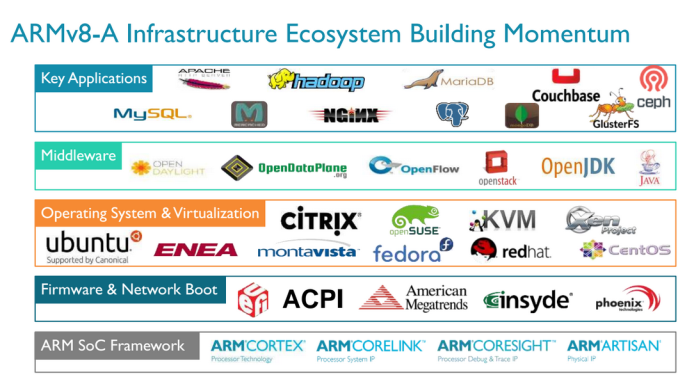ARM Challenging Intel in the Server Market: An Overview
by Johan De Gelas on December 16, 2014 10:00 AM ESTThe Evolving Server Market
The previous page might give you the impression that we do not give the ARM players a chance against mighty Intel. That is not the case, but we believe that the wrong arguments are often used. Intel's success was also a result of the huge amount of Windows desktop users that were enthusiastic about using their Windows knowledge in a professional environment. The combination of Windows NT and the success of the Pentium Pro was very powerful.
ARM also has such a "Trojan software horse" and it is called the Linux based cloud. We're not saying anything new when we say that cloud services have really taken off and that the Internet of Things will make cloud services even more important. Those cloud services have been creating a tsunami of innovation and are based on open source projects such as Hadoop, Spark, Openstack, MongoDB, Cassandra, good old Apache, and hundreds of others. That software stack is ported or being ported to the ARM software ecosystem.
But you probably knew that. Let's make it more concrete. Just a while ago we visited the Facebook hardware lab. Being a server hardware enthusiast, we felt like a child in a large toy store. Let me introduce you to Facebook's Open Vault, part of the the Open Compute Project:
... is a simple and cost-effective storage solution with a modular I/O topology that’s built for the Open Rack. The Open Vault offers high disk densities, holding 30 drives in a 2U chassis, and can operate with almost any host server.
Mat Corddry, director of hardware of engineering showed us the hardware:
The first incarnation of the "honey badger" micro server is based on Avoton. But nothing is stopping Facebook from using an ARM micro server in their Open Vault machines if it offers the same capabilities and is cheaper and/or lower power. As cheap storage is extremely important in the "Big Data" age, this is just one of the opportunities that the "smaller" ARM server SoCs have. But it also makes another point: they have to beat the Intel SoCs that are already known and used.












78 Comments
View All Comments
JohanAnandtech - Tuesday, December 16, 2014 - link
Did you miss this page?http://www.anandtech.com/show/8776/arm-challinging...
The software ecosystem is developing...there is no indication that this will stop soon.
Kevin G - Wednesday, December 17, 2014 - link
The LAMP stack is there and can easily give ARM a foot hold. Scaling up they'll need vendors like Oracle to port key applications. ARM will also need to enhance there RAS to be production capable with that software.Samus - Tuesday, December 16, 2014 - link
Johan,You need to review the compatibility of the Xeon E3's. They actually work in just about any Intel 80 or 90-series board. I have an E3-1230v3 in an Asus ITX H87 on the PC I'm currently typing on.
A C220 chipset is NOT required.
JohanAnandtech - Tuesday, December 16, 2014 - link
you are right :-).By "Xeon E3 needs C220" I meant that you need to add that part to calculate the power consumption per node. And the E3 needs it to support ECC RAM.
eanazag - Tuesday, December 16, 2014 - link
Ubuntu's ARM version OS is a big deal. I believe the fact that MS had been dragging on with supporting RT was in fact to have something to port to the server side. Even though RT is mostly a dud at first, it could still be sensible and sell in a server config.I'm waiting for AMD to finally sell the ARM chip in the channel so I can throw a mobo with it together. If it has 10GbE I would be all over it.
rootheday3 - Tuesday, December 16, 2014 - link
Intel also has Rangeley soc which includes crypto block for comms usagewintermute000 - Tuesday, December 16, 2014 - link
"What if I need massive amounts of memory but moderate processing power? The Xeon E3 only supports 32GB."Thousands of techs labbing away @ home nod sagely in agreement. Right now our choices are to scale horizontally or live with loud jet-engine ex-enterprise gear, because I can't get 64gb of RAM into a whitebox.
wintermute000 - Tuesday, December 16, 2014 - link
Clarification: a whitebox that I can afford i.e. not a Xeon E5. lolbeginner99 - Wednesday, December 17, 2014 - link
What kind of servers use tons of RAM and little processing power? Right, memcached and similar stuff. But let's be honest. That is still a niche market given the total server market. Most servers are just standard multipurpose servers running some company internal low-traffic (web) application. They don't need memcached. Memcached is for huge internet deployments and let's be honest that in itself is niche.I work in a 10'000 people company and I would bet you $1000 we have 0 memcached servers. I don't really know except for the lack of performance in core apps and the questionable competency of our IT.
bobbozzo - Wednesday, December 17, 2014 - link
VM servers.And ZFS-filesystem storage (NAS/SAN) servers. e.g. FreeNAS. Add much more RAM if using DeDup.